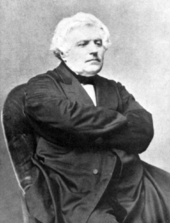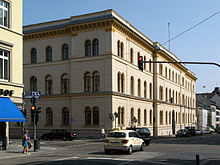Carl Boos
Georg Christian Carl Boos (born September 8, 1806 in Weilburg , † July 18, 1883 in Wiesbaden ; full name: Georg Christian Carl Boos ) was a German architect and Nassau construction clerk .
life and work
Boos was born in Weilburg in 1806 as the son of the Nassau auditor Johann Andreas Boos. He attended the Philippinum , a high school in his hometown. He then studied in Karlsruhe with the grand ducal court architect Friedrich Weinbrenner . From 1826 he studied statics, mechanics, chemistry, mineralogy and geology at the Albert-Ludwigs-Universität Freiburg . In 1829 he moved to the Philosophical Faculty of the Ruprecht-Karls-Universität Heidelberg .
In 1835 Boos was accepted into the Nassau civil service, in that year he moved to Wiesbaden, where he stayed until the end of his life.
In 1837 he submitted a draft for the ministerial building on Luisenstrasse. This was a Nassau government building, today the Hessian Ministry of Justice is housed in the building, which was executed in the neo-renaissance style .
In 1842 he was appointed building officer by Duke Adolph .
From 1849 to 1857 Boos was in charge of the neo-Gothic renovation of Schloss Schaumburg near Balduinstein on the Lahn for Archduke Stefan of Austria .
In 1856 he was appointed senior building officer. During this time he created a general construction plan for the Wiesbaden residence. In the north (around the Nero Valley ) and in the east ( villa area east ) this envisaged a loose villa development and in the west and south (see also the historical pentagon , ring road ) a closed development.
From 1852 to 1862 he built the Protestant market church in the brick Gothic style , which, despite its enormous volume, fits perfectly into the overall ensemble on Schlossplatz in the heart of the city due to its delicate building structure . The church was also called the "Nassau State Cathedral", which highlights the competitive situation with the then Catholic Mainz . The market church is still the tallest building in the city at 98 m.
In 1859 Boos designed the grave monument for Duchess Pauline, which was erected in the cemetery on Platter Strasse and restored in 2007.
In 1866 Nassau was annexed by Prussia , Boos was advised to retire, two years later he retired after receiving the Order of the Red Eagle . In 1883 he died after a long illness and was buried in the cemetery on Platter Strasse . The Karl-Boos-Straße ( ▼ ; between Riederberg street and road Platter) reminded of him.
literature
- Ulrike Milas-Quirin: The new building of a government building for the Duchy of Nassau, in: The government building in Wiesbaden, Taunusstein, 1993, pp. 9–31; ISBN 3-922027-90-3 .
Individual evidence
- ↑ Oberbaurath Boos †. In: Centralblatt der Bauverwaltung , 3rd year 1883, No. 32 (from August 11, 1883) ( online ), p. 292.
| personal data | |
|---|---|
| SURNAME | Boos, Carl |
| ALTERNATIVE NAMES | Boos, Georg Christian Carl (full name) |
| BRIEF DESCRIPTION | German architect and Nassau construction officer |
| DATE OF BIRTH | September 8, 1806 |
| PLACE OF BIRTH | Weilburg |
| DATE OF DEATH | July 18, 1883 |
| Place of death | Wiesbaden |


